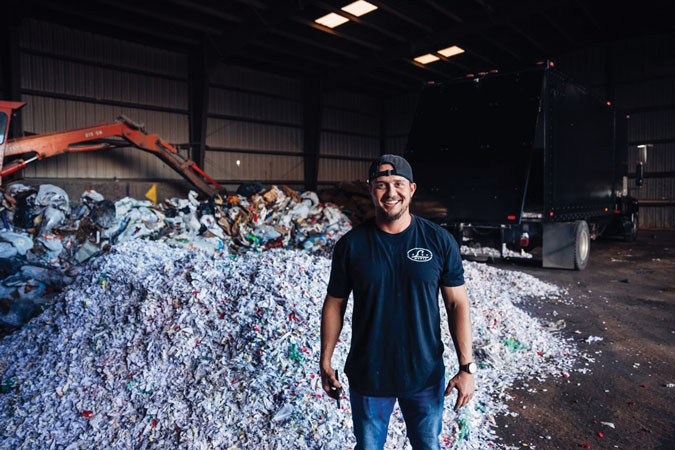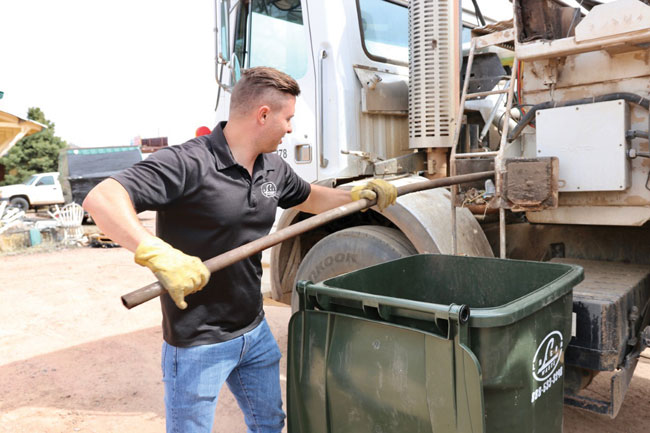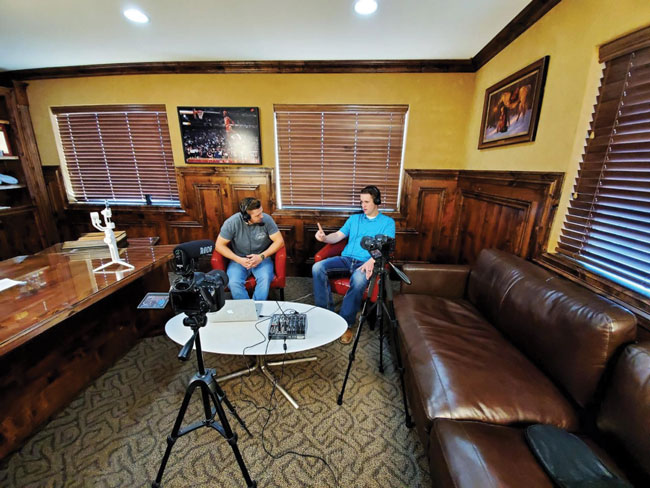Focusing on their current rate of organic growth as well as making acquisitions, Larson Waste has made a continuous effort to show the challenges and the rewards for being in the waste and recycling industry by openly communicating with customers what goes on behind the scenes every day.
The organization known as Snowflake Sanitation was established in the 1970s by Garett Larson’s maternal grandfather, servicing the Snowflake, AZ area. In 1999, Garett’s father was managing Snowflake Sanitation while operating his own business, Larson Truck. Garett’s wife’s grandfather owned a roll-off company and had an old roll-off truck and a few other trucks sitting in his yard. Knowing Garett’s father for a long time, he gave him the old roll-off truck and some roll-offs and told him to make something out of them. That was the beginning of Larson Waste. Eventually, the company purchased Snowflake Sanitation and Garett’s father ran Larson Waste until his retirement in 2016 when Garett took over as CEO.

Photos courtesy of Larson Waste.
When stepping into the role, Garett’s main goal was to put into place some standard operating procedures (SOPs) through systemization. “We were very people driven and we had one really good operations manager, one really good mechanic and one really good office manager that everything revolved around. Our goals were to systemize things because we had just acquired one of our competitors and we were growing really fast, so we needed more SOPs based on what our people handle day-to-day. For example, one of our SOPs now is that we have a training program where we can plug in any driver and get the same results, while keeping the high level of customer service,” says Garett.
Serving three counties in Arizona—Navajo, Apache and Coconino—Larson Waste currently has 52 team members, 70 fleet vehicles, 25 of which are garbage trucks, and the rest are tractor trailers, roll-offs, service, and delivery trucks, as well as medical waste and shredding trucks. Serving 12,000 residents, 3,500 commercial customers, and 120 roll-off customers, the company also operates two transfer stations and works out of two maintenance shops.

Covering the Business
Not knowing what to expect when COVID hit, Larson Waste set out to develop a contingency plan. Garett said the biggest concern was making sure they knew what was going to happen if they saw big drops in revenue and people not being able to pay their bills. “We built out a contingency plan on exactly how we would handle the business if there were any substantial drops in revenue. There was an agreement made among the management that if there was a certain percentage decrease, we would all take a pay cut,” explains Garett. “That trickled down with the intention of not having to lay anyone off. I think this plan gave our employees a lot of confidence to know exactly where they stood and what the plan was. Everyone felt very confident and secure in their job. As a result, we ended up having our most profitable year in 2020 and that is continuing to look the same in 2021.” The company considered layoffs as a last resort option and made plans that would make that as unlikely as possible. Garett is very proud that the company has never made a single layoff. He stresses that a contingency plan will be developed on a yearly basis. “This helped us face the year with a solid plan, leaving the company much more confident in our future.”
Larson Waste was already meticulously cleaning before COVID, with trucks getting cleaned once per week, so they upped the sanitizing as needed and kept meetings in smaller groups, moving from 40 employees to five at a time. “Overall, the events of COVID have helped us grow as a business. In the early half of 2020, as a precaution, we reduced our office staff to 50 percent working in the office and the other half working remotely, alternating days. While COVID brought big changes, positive things came out of it as well. Learning how to do this has given us opportunities that we did not see before, such as office staff being able to work from home when their children are out of school for the summer.”

Garett believes that the industry faces much more dangerous things than COVID on a daily basis and points out that that the biggest impacts from the pandemic are yet to come. “We have found it more difficult to find the parts for trucks and especially dumpsters because our dumpster manufacturers we work with are having a hard time getting steel. Many of them are on back order. I believe that the
shutdowns that happened during COVID will affect all industries for the next several years. In some cases, it’s challenging, but we know that everyone is dealing with it, including our competitors. As inflation is hitting the economy, we are staying ahead of the curve by openly communicating with our customers while we raise our rate to keep up with the rising cost of everything.”
Despite these setbacks, Garett feels proud of how his team dealt with challenges throughout 2020. “I knew many of my guys could have decided to take unemployment, but we didn’t have a single employee go that route. They came in and got their job done every single day. Our employees have really impressed me through this
pandemic.” Garett says they are currently operating normally, stressing that it was a good exercise in making adjustments quickly, moving on the fly and addressing any issues.
Internal Operations
On the safety side, Larson Waste saw a decrease in incidents. In 2018, the company developed an incentive program built around safety. Employees receive a bonus (paid out quarterly or annually at the end of the year) depending on their incident rate. “We saw huge decreases in safety incidences when we created that program. We created the program on how much would be doled out depending on what happened and how much it will cost the company. Implementing that safety bonus program really helped lower safety events. We would also review any incidents once per month and hold safety meeting with drivers to talk about what happened. We also go over certain times of year when there will be high traffic and what is necessary to get ready for that month (such as back to school),” says Garett.
When it comes to recruiting, one unique thing that Larson Waste does is to make social media videos about working at the company. “We found that it keeps our pipeline really full with drivers. We have made a few cool and entertaining videos about the day in the life of drivers and, as a result, we constantly have a big pile of applications because we brand our company as a fun place to work while also showing how cool the waste industry can be and fighting the stigma that is around trash. That has really had a lot of impact. Using Instagram, LinkedIn, Facebook and our own website to put out these videos, we have found a lot of success in people wanting to come and work here,” comments Garett.
Larson Waste also uses social media platforms to communicate with customers, posting on Facebook multiple times per day. Garett says the company gets a lot of feedback from people who appreciate Larson Waste communicating route pickups, etc. In addition to using social media for outreach, each month the front office will decorate around the company logo and give a free month’s pickup service to the first person who guesses how they are going to decorate it. Garett points out that everyone is starting to get back to in-person events and the company likes to get involved in holiday events, such as the parades, fundraisers or the community’s hot air balloon festival. They will also provide non-profit organizations trash service for many of their events. Larson Waste also has a podcast called “Trash Talk”, where Garett talks to local business owners. “People are really excited if someone or a business they know is on the podcast. I’ll take interview suggestions from previous spotlights or people in the community that send us e-mails, or someone that I know, and I’ll invite them to talk about their business and their impact in the community.”
Industry Challenges
Garett says that the largest challenge that the industry faces is government regulation. “I feel that some regulations are overbroad, and they need to be more specific about certain areas. Several things that we run into that are challenging, and the state and federal levels don’t understand the area or the dynamics of things. For example, much of the mandates for truck emissions are created even before manufacturers can figure out how to fix it.”
In addition, hiring people has its own set of challenges. “Speaking with other owners in the industry, it is also a real challenge to find high quality employees. We have spent a lot of time addressing this at Larson Waste, and it’s my belief that the waste industry has an image problem that is not being addressed in a major way. I think that being a trash man in general has a bad stigma and, as mentioned, we have taken to social media to address this in our area. We make a continuous effort to show the challenges and rewards for being in this industry and put it in a much more positive light. As a result, this has created a situation where we are choosing from multiple qualified candidates instead of always looking for one,” says Garett.
Looking Forward
Growing pains, like any growing company, is the question of where is best to allocate resources. Garett points out that Larson Waste has outgrown their shops and they are looking at expanding their transfer station and maintenance shop to accommodate what is happening in the area as well as acquiring new trucks and containers to keep up with the demand. At the same time, they are expanding into different waste services. “Last year we began shredding and document destruction. About a month ago, we began container cleaning services as well and so we are expanding in ways of new services and some of those are in new areas as well. For example, where our residential and commercial trash pickup are in defined Northeast areas of the state, for our medical waste services, we cover all of Arizona. We are
looking to expand in all areas of the business depending on which revenue stream it is.”
Next up, Larson Waste is looking to own and operate a landfill that is certified for C&D waste as well as waste ash from a green waste energy plant. They are also looking to re-certify the landfill so that it will be able to take municipal waste and they are looking for a partner to operate that landfill. “We are intentional with continuing our current rate of organic growth as well as making acquisitions,” says Garett.
He continues, “Our business has really been a family legacy and I think that is something that is very special about that waste industry. My dad was able to take on what my grandpa had built and got a helping hand from others and I have been able to build off all of the hard work that he put into it. We are combating challenges by being intentional and planning. Our systems have given us the space to be forward facing and not completely consumed with the task of each day.” | WA
For more information, visit www.larsonwaste.com. Follow “Garett the Trashman” on social media.
